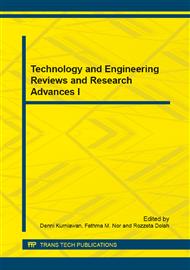p.278
p.282
p.289
p.294
p.299
p.304
p.311
p.319
p.326
Feasibility, Flexibility and Sensitivity Tests on Delta Temperature Minimum to Obtain Operable and Flexible Heat Exchanger Network
Abstract:
This paper explains about the controllability effect on delta temperature minimum (ΔTmin) in order to get flexible and operable heat exchanger network (HEN). There are many researches based on design and cost effect to ΔTmin contribution. However, there are lacks of study on how the ΔTmin effect to controllability of HENs. Therefore, this paper focuses on controllability analysis of different HENs design based on ΔTmin contribution. There are six HEN designs were obtained from different ΔTmin values such as 20°C, 25°C, 30°C, 35°C, 40°C and 50°C and has been analyzed. The analysis consists of three different controllability tests which are feasibility, flexibility and sensitivity. Feasibility test is used to check either the HEN design is feasible or not. Next, the feasible HEN design is then analyzed in terms of flexibility. The flexibility test is used to calculate the design flexibility in terms of how much the percentage the design can handle under uncertainties. Lastly is to test the process sensitivity with respect to disturbance changes. Throughout the controllability tests, several options for control structure were built and analyzed. A simple HEN case study was used to analyze the controllability.
Info:
Periodical:
Pages:
299-303
Citation:
Online since:
February 2015
Price:
Сopyright:
© 2015 Trans Tech Publications Ltd. All Rights Reserved
Share:
Citation:


